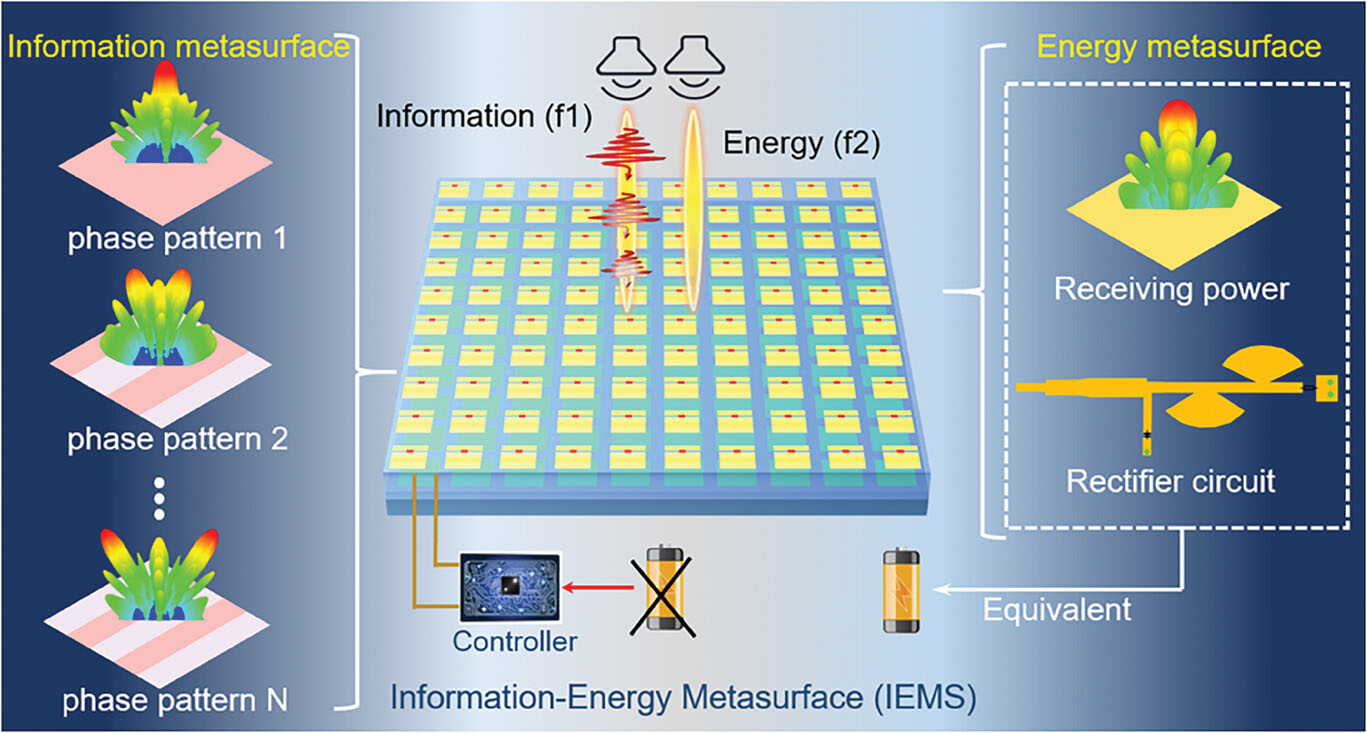| Mar 04, 2024 | |
Revolutionizing programmable metasurfaces with wireless power transfer |
|
| (Nanowerk Spotlight) Programmable metasurfaces have shown great potential for advanced electromagnetic wave manipulation in wireless communications, sensing, and other applications. However, a major limitation has persisted – the need for cumbersome wired DC power connections to supply control circuitry embedded in these metasurfaces. This has hampered adoption, especially in remote or inaccessible deployment locations. | |
| Metasurfaces are planar arrays of subwavelength resonant structures that can shape and steer electromagnetic waves in almost arbitrary ways by imparting local, customizable phase shifts. Integrating tiny active electronic components into each unit cell allows real-time reconfigurability through external control signals. But this necessitates DC power delivery to drive these components. Workarounds using solar cells or optical illumination have had limited success. A more robust and consistent solution has been lacking – until now. | |
| Researchers from Xidian University and Southeast University in China have developed an innovative approach that could eliminate this constraint. This new study, published in Advanced Materials ("Tailless Information–Energy Metasurface"), seamlessly combines wireless power transfer technology with information metasurfaces to create the first reported self-powered “tailless” programmable metasurface platform. Dubbed information-energy metasurfaces (IEMS), these hybrid devices can wirelessly harvest ambient electromagnetic energy from their environment to power dynamic wavefront manipulations without any wired connections. | |
 |
|
| Conceptual illustration of the tailless information-energy metasurface (IEMS). The IEMS comprises an information metasurface and an energy metasurface. The left section of the figure illustrates the electromagnetic modulation properties of the information metasurface, while the right section presents the power transmission mode of the energy metasurface. (Reprinted with permission by Wiley-VCH Verlag) | |
| “By eliminating cumbersome DC wires and stabilizing the power supply, this approach expands the applicability of programmable metasurfaces to harsh deployment settings where access is restricted,” explained Dr. Long Li, Professor at Xidian University and co-corresponding author of the paper. “We envision tailless IEMS becoming indispensable components of future electronic systems and communication networks, enhancing functionality while simplifying infrastructure needs.” | |
| The key innovation lies in a coplanar architecture that merges two distinct functional metasurfaces together. The foreground “information metasurface” layer contains an array of cells loaded with PIN diodes to enable software-defined rerouting of signals at 5.8 GHz. Behind it, a backing “energy metasurface” layer with integrated rectifiers absorbs ambient RF energy at 4.1 GHz, converts it to DC power and feeds it to the PIN diode control circuits. Wireless information manipulation and power harvesting thus occur concurrently within an integrated package. | |
| In testing, the integrated platform demonstrated exceptional performance, supplying over 500 mW of stable DC power for continuous reconfiguration capabilities. This power sufficiency enabled significant achievements, such as radar beam redirection, Wi-Fi signal enhancement, and antenna pattern tuning on demand. Field tests further validated the system's robustness, managing wireless channel regulation across a 40° angular range and transmitting real-time video without distortion. These results underscore the practical efficacy and potential of IEMS in various applications. | |
| “Compared to prior electrically or optically tunable metasurfaces, our integrated IEMS platform offers a simpler, lower cost solution without compromising control capabilities,” said Dr. Tie Jun Cui, Professor at Southeast University and co-corresponding author. “The self-sustaining power supply could greatly expand applicability for smart walls, reconfigurable antennas, dynamic metalens holograms, and other applications where access is limited.” | |
| The study provides the first working example of wireless-powered adaptive metasurface technology - essentially adding an entire additional functional dimension beyond wave manipulation abilities. This pioneering device could one day lead to exotic “smart surface” coatings able to configure their own responses using surrounding electromagnetic sources as both power inputs and data carriers. | |
| The demonstrations carried out here serve as an important proof of concept. But the authors point out that further optimization of the energy harvesting, voltage regulation and conversion circuitry could improve efficiency and standalone operation times. Leveraging more directive energy scavenging antennas or higher-density component integration could also enable smaller, more agile platforms. | |
| While the study marks a significant leap forward, the authors acknowledge the need for further optimization in energy harvesting, voltage regulation, and conversion circuitry to boost efficiency and extend standalone operation times. Exploring more directive energy scavenging antennas and denser component integration could pave the way for smaller, more agile platforms. Addressing these challenges is crucial for advancing the technology's application scope and realizing its full potential in dynamic environments. | |
| Nonetheless, by solving a long-standing challenge that has plagued the field and restricted functionality, this groundbreaking study paves the way for self-sustaining, wirelessly controllable intelligent metasurfaces. These metasurfaces could potentially self-optimize in complex changing environments, revolutionizing capabilities without complicating infrastructure needs - a truly pivotal advancement towards more ubiquitous smart surface technologies. | |
 By
Michael
Berger
– Michael is author of three books by the Royal Society of Chemistry:
Nano-Society: Pushing the Boundaries of Technology,
Nanotechnology: The Future is Tiny, and
Nanoengineering: The Skills and Tools Making Technology Invisible
Copyright ©
Nanowerk LLC
By
Michael
Berger
– Michael is author of three books by the Royal Society of Chemistry:
Nano-Society: Pushing the Boundaries of Technology,
Nanotechnology: The Future is Tiny, and
Nanoengineering: The Skills and Tools Making Technology Invisible
Copyright ©
Nanowerk LLC
|
|
|
Become a Spotlight guest author! Join our large and growing group of guest contributors. Have you just published a scientific paper or have other exciting developments to share with the nanotechnology community? Here is how to publish on nanowerk.com. |
|
